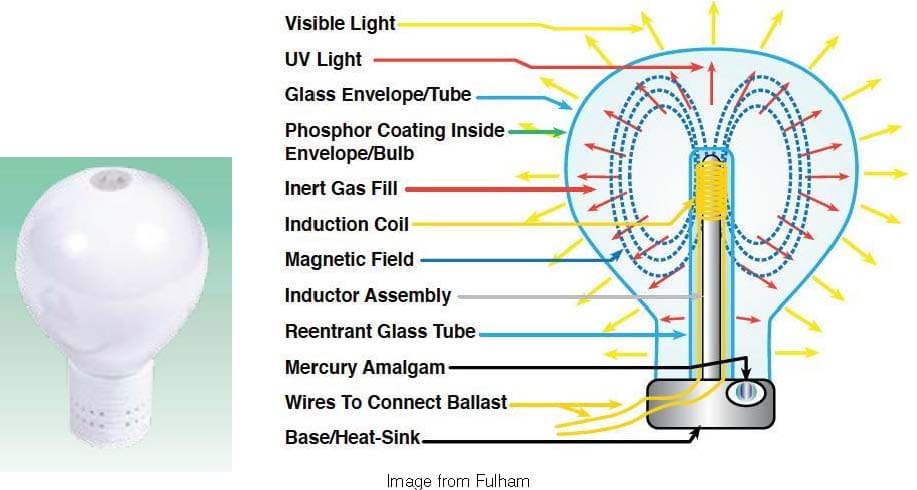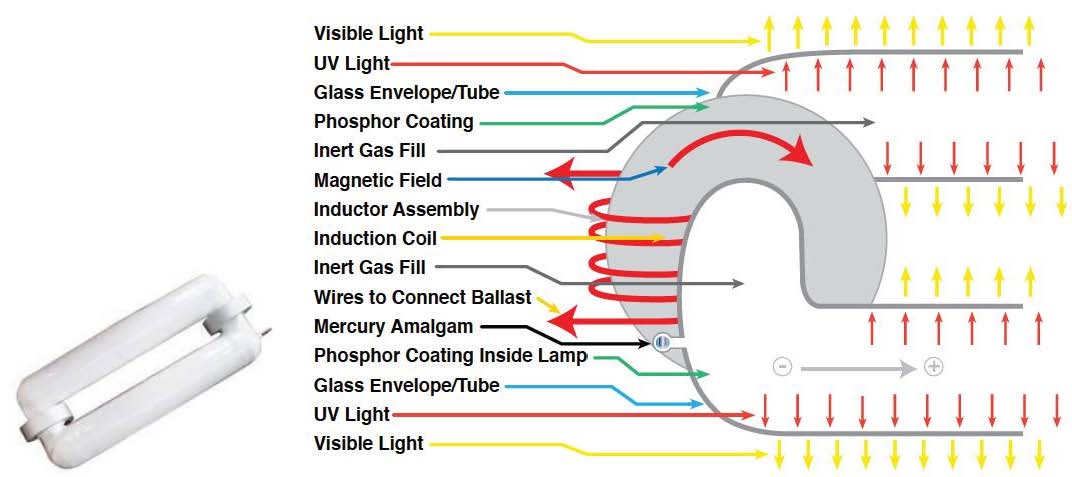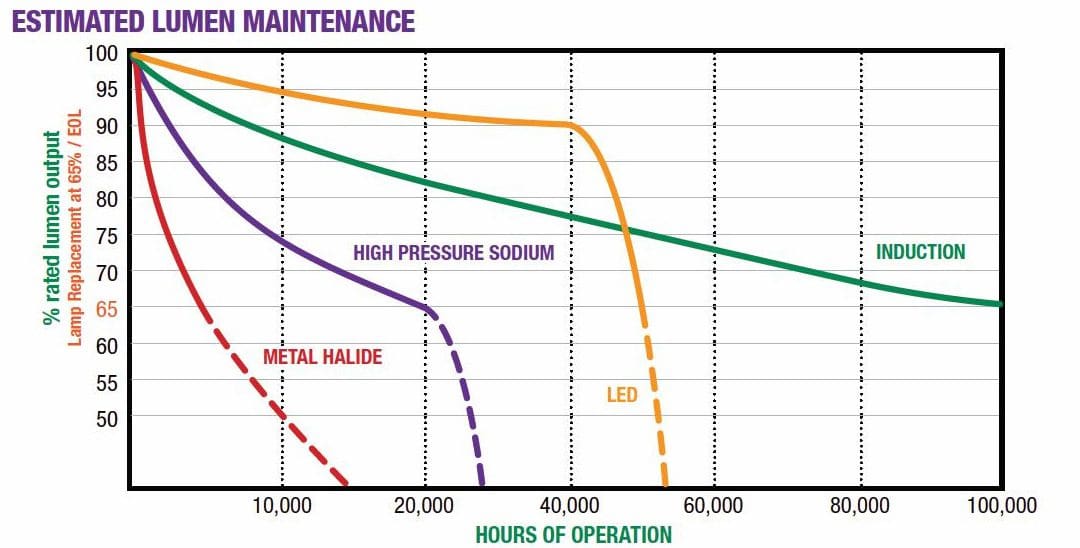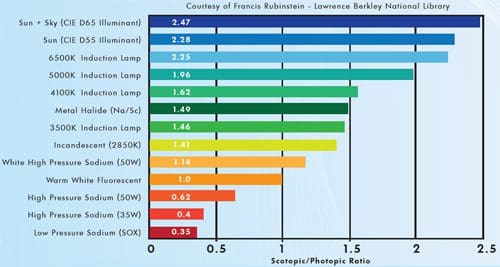Overview
Invented in 1890 by Nikola Tesla and used commercially over the past 16 years, induction technology is basically fluorescent lamp lighting without electrodes. It uses magnetic induction to ignite the phosphors instead of electrodes. The main advantages of induction technology are as follows. Electrodes are a significant point of failure on traditional fluorescent lamps causing more frequent replacement. Induction lamps do not have electrodes and consequently have an extremely long life, rated at 100,000 hours. Also, the lack of electrodes makes them more reliable in high-vibration applications. The second major advantage is the ability to use light generating substances that would react with metal electrodes in normal lamps, enabling the use of higher performance substances for more light.
Induction technology delivers an unequaled 100,000 hours of high quality white light which makes them virtually maintenance free. After 100,000 hours, 50% of the drivers will be surviving and at 60,000 hours about 10% failures are expected. 100,000 hours of life is 11 years of life even when run 24/7, or 25 years when operated 10 hours per day. Induction fixtures are virtually maintenance free. That is the equivalent of 100 incandescent lamps, 5 HID lamps, or 5 typical fluorescent lamp life cycles.
The light generated is a crisp white light with 80+ CRI, high reliability and instant on/off. Induction fixtures provide stable light output over a wide range of ambient temperatures, maintaining at least 85% of nominal lumens from -30° F to 130° F when used in an enclosed fixture with a heat sink. Additionally, induction systems can start at temperatures as low as -40°F.
Induction fixtures are energy efficient, too. A 250w Induction lamp can be compared to a new probe start 400w Metal Halide from a light output standpoint, however a 250w induction fixture uses 265 watts while the 400w HID uses approximate 454 watts. The savings is 189 watts. If operated 5 days a week, 12 hours a day and electricity costs $.12/kwh the annual savings in just energy is $69.93 per fixture. The maintenance and replacement savings are significant, too. Another one of the advantages is that induction fixtures operate at a lower temperature than competitor fixtures reducing cooling costs where applicable.
Induction Benefits Summary
- Reduces energy use by over 50% as compared to HPS
- Reduced maintenance cost with 4 to 10 times the lamp life
- Improved safety conditions with more consistent performance
- Improved Security conditions with crisp whiter, higher CRI light
- Enhanced visual performance with high CRI
- More environmentally friendly solution using less energy and less waste disposal
- May qualify for energy company rebates
How Induction Works — Internal Magnetic Induction
In a variation of this technology, internal magnetic induction lamps use a light bulb shaped glass lamp, which has a test-tube like re-entrant central cavity. This cavity is coated with phosphors on the interior, filled with inert gas and a pellet of mercury amalgam. The induction coil is wound around a ferrite shaft which is inserted into the central test-tube like cavity. The inductor is excited by high frequency energy provided by an external electronic ballast (generator) causing a magnetic field to penetrate the glass and excite the mercury atoms, which emit UV light, that is converted to visible light by the phosphor coating by the phosphor coating.
How Induction Works – External Induction Lamps
External magnetic induction lamps are essentially fluorescent lamps with electromagnets wrapped around a section of the lamp tube. High frequency energy, from the electronic ballast (generator), is sent through wires, which are wrapped in a coil around the ferrite inductor, creating a powerful magnet. The induction coil produces a very strong magnetic field which travels through the glass and excites the mercury atoms in the interior which are provided by a pellet of amalgam (a solid form of mercury). The mercury atoms emit UV light and, just as in a fluorescent tube, the UV light is up-converted to visible light by the phosphor coating on the inside of the tube. The system can be considered as a type of transformer where the inductor is the primary coil while the mercury atoms within the envelope/tube form a single-turn secondary coil.
How Long Will an Induction Lamp Operate?
External induction lamps manage heat either by convection through the air or conduction into the fixture. Induction lamps operate with a higher internal temperature and must cool by conduction to the base heat sink and by radiation through the glass walls. With induction, a small percentage of mercury ions are absorbed by the phosphor coating over time; once the mercury ions inside the envelope are depleted, the lamp emits only a very dim light and has to be replaced.
Induction Rated Lumen Maintenance is largely determined by operating temperature of the lamp and quality of lamp design. The induction systems used by Access Fixtures are designed and manufactured with high quality tri-phosphors and solid amalgam to optimize the performance and rated life of the lamp. The above chart is intended to represent an average rated lumen output stated as a percentage of the initial lumen output over the rated life of the lamp. Operating the lamp within the temperatures specification will typically result in an average estimated 70% lumen output at 60Khrs.
How Can an 84 Watt Induction Luminaire Replace a 150w HPS Luminaire?
The answer is found in how the human eye responds to light and how lighting sources affect vision. To better understand consider the following scientific terms and how they relate to vision:
- SCOTOPIC VISION –The scientific term for human visual perception in low light(night vision); directed by rod cells in the human eye.
- PHOTOPIC VISION –The scientific term for human color vision under normal conditions during the day, directed by cone cells in the human eye.
- MESOPIC VISION –The scientific term for the combination between Photopic and Scotopic vision taking into account the total sensitivity of the rod cells in the eye for the blue range, with the color perception of the cone cells.
Extensive research has been conducted to better understand Mesopic vision; more specific how Scotopic vision which stimulates the photoreceptors called rods in the human eye to cause pupil contraction and increased visual acuity. It was found that scotopically enhanced light appeared brighter even when light levels were reduced; thus the potential to reduce wattage and improve lighting.
The ratio of Scotopic light vs. Photopic light in a lamp is called the S/P ratio. This ratio determines the apparent visual brightness of a light source. Induction lighting produces a high S/P ratio and this is why the 85w lamp appears as bright or brighter to the human eye than a sodium vapor or metal halide of twice the wattage. Visual Effective Lumens (VEL) is a key factor in vision.




